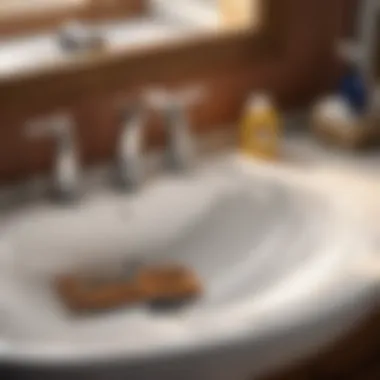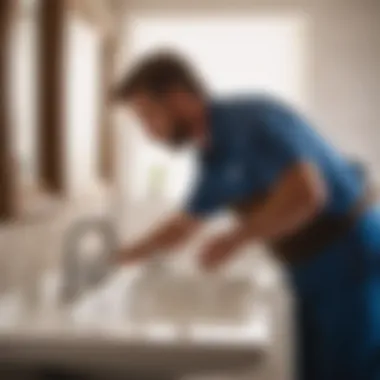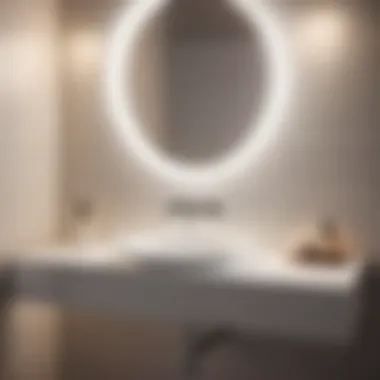Expert Troubleshooting Guide: Fixing a Dripping Bathroom Sink with Ease


Materials:
- Adjustable wrench
- Pipe wrench
- Plumber's tape
- Plunger
- Bucket
- Towels
- Replacement washers or cartridges
DIY Steps:
- Identifying the issue: Start by locating the source of the drip and determining if it's from the faucet or the pipes underneath.
- Shutting off water: Turn off the water supply to the sink using the shut-off valves under the sink.
- Removing the faucet handle: Use an adjustable wrench to loosen and remove the handle to access the internal components.
- Inspecting the washers or cartridges: Check the condition of the washers or cartridges for wear or damage, which can cause leaks.
- Replacing washers or cartridges: If needed, replace the damaged washers or cartridges with new ones of the same size to ensure a proper seal.
- Reassembling the faucet: Put the faucet handle back in place, making sure all parts are securely attached.
- Testing the repair: Turn on the water supply and check for any remaining leaks.
Technical Aspects:
- Tools: An adjustable wrench and pipe wrench are essential for removing parts. Plumber's tape helps create a watertight seal.
- Timing specifics: The repair process can vary based on the issue but generally takes around 30-60 minutes.
- Critical techniques: Properly tightening parts, ensuring correct alignment, and using plumber's tape are crucial for a successful repair.
DIY Project Process:
- Sequential Steps: Begin by turning off the water supply, then proceed to dismantle and inspect the faucet components before replacing any necessary parts.
- Troubleshooting Tips: If leaks persist, double-check the tightness of connections and ensure all components are properly aligned. Additionally, applying plumber's tape can help reinforce seals.
Introduction
In the realm of household maintenance, a dripping bathroom sink can pose not only an annoyance but also a potential threat to your property. This troubleshooting guide delves deep into understanding the gravity of a dripping bathroom sink and equips you with the knowledge needed to address this issue effectively. From subtle signs that hint at a dripping sink to the implications of ignoring this common household problem, this comprehensive guide sheds light on the importance of taking prompt action.
Understanding the Gravity of a Dripping Bathroom Sink
Signs of a Dripping Sink
When it comes to identifying a dripping sink, keep a vigilant eye out for subtle clues such as consistent water droplets pooling around the faucet or a persistent, rhythmic dripping sound. These signs not only indicate a leakage issue but also point towards potential water wastage. By recognizing these signs early on, you can prevent escalation of the problem and save your fixtures from damage.
Implications of Ignoring the Issue
Ignoring a dripping bathroom sink may seem inconsequential at first glance, but the implications can be more severe than anticipated. The continuous dripping not only leads to water wastage but also has the potential to damage your bathroom fixtures over time. From water stains to mold growth, the consequences of neglecting a dripping sink can extend beyond mere inconvenience. By unraveling the implications of this issue, you will realize the urgency of addressing it promptly.
Importance of Prompt Action
Preventing Water Wastage


One of the key reasons to promptly tackle a dripping sink is to prevent unnecessary water wastage. With each drop that escapes, precious water resources are squandered. By taking swift action to repair the leak, you not only contribute to water conservation efforts but also save on your utility bills in the long run. The importance of preserving this vital resource cannot be overstated in today's conservation-conscious world.
Potential Damage to Fixtures
Apart from water wastage, a dripping bathroom sink poses a threat to the very fixtures that make up your bathroom. The constant moisture exposure can lead to rust, decay, and structural damage, compromising the integrity of your sink and surrounding components. By addressing the issue promptly, you protect your fixtures from premature wear and tear, ensuring their longevity and functionality. Understanding the potential damage that a dripping sink can inflict empowers you to take proactive measures to safeguard your bathroom's infrastructure.
Identifying the Cause
When it comes to troubleshooting a dripping bathroom sink, one of the most crucial steps is identifying the cause behind the issue. By understanding the root of the problem, you can efficiently address it and prevent further complications. This section dives deep into the importance of pinpointing the cause, emphasizing specific elements such as accurate diagnosis, cost-effectiveness, and ensuring long-term solution.
Possible Reasons Behind the Dripping
Worn Out Washer
A worn-out washer is a common culprit when it comes to a dripping bathroom sink. This component, found within the faucet, experiences wear and tear over time, leading to water leakage. The key characteristic of a worn-out washer is its susceptibility to deterioration due to constant use. While it may seem like a small part, a faulty washer can result in significant water wastage. Replacing this inexpensive yet vital piece can restore the functionality of your sink.
Loose Faucet Handles
Loose faucet handles can also contribute to a dripping sink. The main characteristic of this issue is the handles not being securely fastened to the faucet, causing gaps where water can seep through. This common problem can often be resolved by tightening the handles using basic tools. Ignoring loose faucet handles can lead to persistent dripping and potential damage to the sink fixtures over time.
High Water Pressure
High water pressure is another potential reason behind a dripping sink. When the water pressure is too high, it can put excessive strain on the faucet components, leading to leaks and drips. Monitoring and regulating the water pressure in your plumbing system is essential to prevent such issues. While high water pressure ensures strong flow, it can cause damage if not kept within optimal levels.
Corroded Pipes
Corroded pipes can also be a hidden cause of a dripping bathroom sink. The key characteristic of corroded pipes is the gradual decay of metal pipes due to exposure to water and other elements. This corrosion weakens the pipes, making them more prone to leaks and drips. Inspecting your pipes for corrosion and replacing damaged sections can prevent further water damage and maintain the integrity of your plumbing system.
Tools for Investigation
Flashlight
A flashlight is an essential tool for investigating a dripping sink, especially in areas with limited visibility. Its key characteristic lies in providing ample light to examine dark or cramped spaces under the sink. The unique feature of a flashlight is its portability and ability to illuminate tight spots, allowing you to identify leaks or damage with ease.
Screwdriver


A screwdriver is a versatile tool that plays a significant role in sink repair investigations. The key characteristic of a screwdriver is its ability to tighten or loosen screws, making it ideal for disassembling faucet components. The unique feature of a screwdriver is its various types and sizes, catering to different screw specifications in plumbing fixtures.
Adjustable Wrench
An adjustable wrench is indispensable when dealing with a dripping sink as it provides a secure grip for tightening or loosening nuts and bolts. The key characteristic of an adjustable wrench is its adjustable jaw width, allowing flexibility in handling different sizes of fasteners. Its unique feature lies in its usability across various plumbing fixtures, making it a must-have tool for sink repairs.
DIY Solutions
DIY solutions play a crucial role in addressing a dripping bathroom sink effectively. They empower homeowners to take matters into their own hands, saving time and money while promoting a sense of accomplishment. In this article, DIY solutions are highlighted as an integral component, providing insight into practical methods to resolve the issue independently.
Step-by-Step Reparation Process
Shutting Off Water Supply
Shutting off the water supply is a pivotal step in repairing a dripping bathroom sink. By isolating the water source, individuals can work on the faucet without any leakage, ensuring a safer and more controlled environment for the repair process. This action significantly reduces water wastage and prevents any potential mess during the repair, showcasing its essential role in rectifying the issue efficiently. The unique feature of shutting off the water supply lies in its simplicity yet effectiveness in halting the water flow, making it a popular choice for individuals undertaking DIY sink repairs.
Replacing a Faulty Washer
Replacing a faulty washer is a common solution for fixing a dripping bathroom sink. This process addresses one of the primary causes of the problem, ensuring a tight seal that eliminates any leaking from the faucet. The key characteristic of this method is its cost-effectiveness and ease of implementation, making it a preferred choice among DIY enthusiasts. While the unique feature of replacing a faulty washer lies in its immediate impact on resolving the leak, its disadvantage may involve requiring specific tools or knowledge for successful execution.
Tightening Faucet Handles
Tightening faucet handles is an essential step in preventing a dripping bathroom sink. Loose handles can result in water seepage, leading to continuous dripping. By securing the handles properly, individuals can restore the functionality of the faucet, minimizing the risk of leaks. The key characteristic of this task is its simplicity and quick execution, offering a straightforward solution to a common problem. However, over-tightening the handles may lead to other issues, highlighting the importance of careful adjustment during this process.
Adjusting Water Pressure
Adjusting water pressure is another significant aspect of fixing a dripping bathroom sink. High water pressure can put strain on the faucet, causing it to leak over time. By adjusting the water pressure to an optimal level, individuals can prevent leaks and maintain the longevity of their fixtures. The key characteristic of this adjustment is its impact on the overall plumbing system, promoting water efficiency and reducing the risk of future issues. However, improper adjustments may affect the water flow in other areas of the house, emphasizing the need for precision when regulating the water pressure.
When to Seek Professional Help
When dealing with a dripping bathroom sink, there comes a point where seeking professional help becomes necessary. Knowing when to call in the experts can save time, money, and further damage. This section outlines the specific elements, benefits, and considerations of seeking professional assistance in resolving persistent issues with your bathroom sink.
Signs Indicating Professional Assistance is Required


Persistent Dripping Despite Repairs
Persistent dripping despite attempts at DIY fixes is a clear sign that a more specialized approach is required. The continual drip may indicate underlying issues that are beyond the scope of simple repairs. Despite initial efforts, the problem persists, underscoring the complexity and severity of the underlying problem. Seeking professional assistance ensures a thorough assessment of the situation, leading to a more permanent solution.
Complex Plumbing System Issues
Complex plumbing system issues pose significant challenges for homeowners. These issues go beyond surface-level problems and require a deep understanding of plumbing systems. The intricate nature of these problems can lead to further complications if not addressed correctly. Professional plumbers have the expertise to navigate complex plumbing systems, identify the root cause of the issue, and implement effective solutions. Their specialized knowledge and experience ensure that even the most intricate problems are resolved efficiently.
Selecting the Right Plumbing Service
When considering professional help for your dripping bathroom sink, choosing the right plumbing service is essential to a successful resolution.
Experience and Certification
A key consideration when selecting a plumbing service is their experience and certification. Experienced plumbers bring a wealth of knowledge and practical skills to the job, ensuring that they can tackle even the most challenging problems with ease. Certification serves as a validation of their expertise, indicating that they meet industry standards and possess the necessary qualifications to handle plumbing issues effectively.
Recommendations and Reviews
Seeking recommendations and reviews can help you make an informed decision when selecting a plumbing service. Customer testimonials and reviews provide insights into the quality of service offered by the plumbing company. Positive recommendations indicate reliability, professionalism, and customer satisfaction, making them valuable criteria in choosing a plumbing service for your bathroom sink issues.
Conclusion
Summary of Key Points
Importance of Timely Action
The importance of timely action lies in its ability to prevent further damage and costs associated with a leaking sink. Timely reparations can safeguard against long-term issues, promoting water efficiency and sustainability. Acting promptly upon noticing dripping faucets can save both water and money in the long run—a proactive approach that aligns with the environmental consciousness of modern homeowners.
Balancing DIY Efforts and Professional Help
Balancing between DIY efforts and professional assistance allows homeowners to leverage their skills while acknowledging the complexity of some plumbing tasks. Knowing when to seek expert help is crucial in ensuring that the problem is addressed comprehensively and accurately. DIY endeavors offer a sense of accomplishment and can be cost-effective, but professional services bring a level of expertise and assurance that is invaluable in intricate plumbing situations.
Final Thoughts
Maintaining a Functional Bathroom
Maintaining a functional bathroom goes beyond aesthetics—it involves preserving the efficiency of plumbing systems to avoid disruptions in daily routines. Regular upkeep and proactive troubleshooting can prevent minor issues from escalating into major plumbing problems, fostering a comfortable living environment for the entire household.
Ensuring Water Efficiency
Ensuring water efficiency is not only environmentally conscious but also economically beneficial. By fixing leakage promptly and making conscious choices in water usage, homeowners can reduce their environmental footprint and cut down on utility bills. Implementing water-saving practices and investing in efficient fixtures contribute to a sustainable household that values resource conservation.







